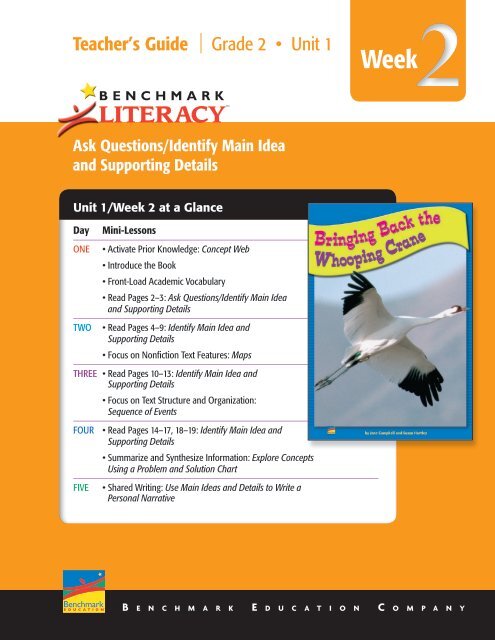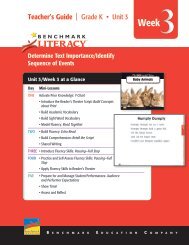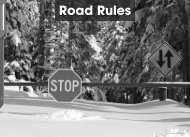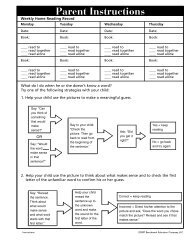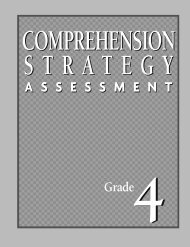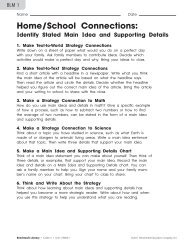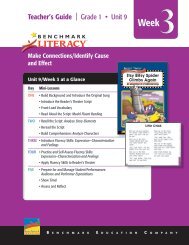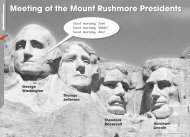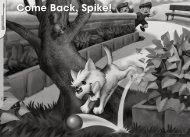Literacy - Benchmark Resources - Benchmark Education Company
Literacy - Benchmark Resources - Benchmark Education Company
Literacy - Benchmark Resources - Benchmark Education Company
Create successful ePaper yourself
Turn your PDF publications into a flip-book with our unique Google optimized e-Paper software.
2<br />
Teacher’s Guide Grade 2 • Unit 1<br />
Week<br />
<strong>Benchmark</strong><br />
<strong>Literacy</strong><br />
TM<br />
Ask Questions/Identify Main Idea<br />
and Supporting Details<br />
Unit 1/Week 2 at a Glance<br />
Day<br />
ONE<br />
TWO<br />
Mini-Lessons<br />
• Activate Prior Knowledge: Concept Web<br />
• Introduce the Book<br />
• Front-Load Academic Vocabulary<br />
• Read Pages 2–3: Ask Questions/Identify Main Idea<br />
and Supporting Details<br />
• Read Pages 4–9: Identify Main Idea and<br />
Supporting Details<br />
• Focus on Nonfiction Text Features: Maps<br />
THREE • Read Pages 10–13: Identify Main Idea and<br />
Supporting Details<br />
• Focus on Text Structure and Organization:<br />
Sequence of Events<br />
FOUR • Read Pages 14–17, 18–19: Identify Main Idea and<br />
Supporting Details<br />
• Summarize and Synthesize Information: Explore Concepts<br />
Using a Problem and Solution Chart<br />
FIVE<br />
• Shared Writing: Use Main Ideas and Details to Write a<br />
Personal Narrative<br />
®<br />
B<br />
e n c h m a r k E d u c a t i o n C o m p a n y
Day One<br />
Read-Aloud (10 m i n u t e s)<br />
Select a favorite fiction read-aloud from your classroom or school library with<br />
which to model the metacognitive strategy “Ask Questions.” Use the sample<br />
read-aloud lessons and suggested titles in the <strong>Benchmark</strong> <strong>Literacy</strong> Overview.<br />
Mini-Lessons (20 m i n u t e s)<br />
Activate Prior Knowledge: Concept Web<br />
Display a blank Endangered Animal Concept Web (BLM 1) like the one shown<br />
here.<br />
Nonfiction Big Book<br />
Lesson Objectives<br />
Students will:<br />
• Build academic vocabulary and<br />
concepts related to endangered<br />
whooping cranes.<br />
• Ask questions about a text.<br />
• Identify main ideas and supporting<br />
details using a graphic organizer.<br />
• Identify and discuss nonfiction<br />
text features (table of contents,<br />
glossary).<br />
• Build oral language and vocabulary<br />
through whole-group and partner<br />
discussion.<br />
Related <strong>Resources</strong><br />
• Endangered Animal Concept Web<br />
(BLM 1)<br />
• Vocabulary Notebook (BLM 2)<br />
• Identify Main Idea and Supporting<br />
Details (BLM 3)<br />
• Write the Details (BLM 4)<br />
Say: An endangered animal is an animal that is in danger of disappearing.<br />
• Why are some animals endangered?<br />
• How can you help endangered animals?<br />
Model sentence frames. Support ELLs by modeling how you use the<br />
following sentence frames:<br />
Some animals are endangered because .<br />
I can help endangered animals. I can .<br />
Open discussion. Record students’ responses on the Endangered Animal<br />
Concept Web. Ask why it is important to help save endangered animals.<br />
Make cultural connections. Invite students who have read about, lived in, or<br />
visited different countries or places to tell about endangered animals they have<br />
seen or learned about.<br />
Tell students that this week they will be reading a book about an endangered<br />
animal called the whooping crane and while they read the book they will<br />
return to the Concept Web to add more information.<br />
protect<br />
forests<br />
How to Help<br />
elephant<br />
whale<br />
Animals<br />
Endangered<br />
tiger<br />
cutting<br />
down trees<br />
Sample Endangered Animal Concept Web Annotations (BLM 1)<br />
Dangers<br />
pollution<br />
2<br />
<strong>Benchmark</strong> <strong>Literacy</strong> • Grade 2 • Unit 1/Week 2<br />
©2011 <strong>Benchmark</strong> <strong>Education</strong> <strong>Company</strong>, LLC
Day One<br />
Introduce the Book<br />
Display the book Bringing Back the Whooping Crane on an easel.<br />
Show students the book cover. Read aloud the title and the authors’<br />
names. Invite students to identify and discuss what they see in the cover<br />
photograph.<br />
Ask: • What do you predict this book will be about?<br />
• Is this book fiction or nonfiction?<br />
• How do you know? Allow responses.<br />
If necessary, point out that this is a nonfiction book. Explain that the<br />
photograph of a real whooping crane provides one clue that readers<br />
can use to predict the genre and topic of the book.<br />
Turn to the Table of Contents. Read the entries with students.<br />
Ask: Why do you think this book has a Table of Contents? Allow<br />
responses.<br />
Guide students to understand that the Table of Contents helps readers<br />
know how the information in a book is organized and what they can<br />
find out by reading the book.<br />
Ask: • What would I read about in “Cranes in Danger”?<br />
• Where would I read about how to save whooping cranes?<br />
Front-Load Academic Vocabulary<br />
Open to the Glossary on page 20. Point to each word, read the<br />
definition, and use the word in a sentence.<br />
If you have students whose first language is Spanish, ask: Does habitat<br />
sound like a word you know in Spanish? (Allow responses.) The English<br />
word habitat sounds like the Spanish word el hábitat. Habitat and<br />
el hábitat mean the same thing. Repeat for other cognates in the book:<br />
migrate/migrar; species/las especies.<br />
Ask students to predict what each word means and use each word in a<br />
sentence.<br />
Make Content Comprehensible<br />
for ELLs<br />
Beginning and Intermediate<br />
Use realia and images from the book to<br />
discuss whooping cranes. Point to the<br />
images on the cover and Table of Contents<br />
and say: This bird is a whooping crane. A<br />
whooping crane is . (white, big,<br />
tall) It has . (wings, a long neck,<br />
black legs) It can . (fly, stand)<br />
Have students repeat the sentences with<br />
you.<br />
All Levels<br />
If you have students whose first language<br />
is Spanish, use the English/Spanish<br />
cognates provided in the Front-Load<br />
Academic Vocabulary section on this page.<br />
Pair ELLs with fluent English speakers<br />
during partner discussions and activities.<br />
Model the use of academic sentence<br />
frames to support ELLs’ vocabulary and<br />
language development. (See suggested<br />
sentence frames provided.)<br />
Support Special Needs Learners<br />
Throughout the week, use the following<br />
strategies to help students who have<br />
learning disabilities access the content<br />
and focus on skills and strategies.<br />
Spend additional time previewing<br />
each chapter to build background and<br />
vocabulary.<br />
Read aloud the text more than once for<br />
students who would benefit from auditory<br />
input.<br />
Use the graphic organizer activities to build<br />
students’ schema related to the book’s<br />
content.<br />
Validate and support students’ efforts to<br />
participate in instructional conversations<br />
and activities.<br />
©2011 <strong>Benchmark</strong> <strong>Education</strong> <strong>Company</strong>, LLC <strong>Benchmark</strong> <strong>Literacy</strong> • Grade 2 • Unit 1/Week 2 3
Day One<br />
Gcaptivity<br />
endangered<br />
habitat<br />
lossary<br />
kept within bounds; birds in captivity<br />
are not free to fly where they want<br />
in danger of disappearing<br />
an area where plants, birds, or<br />
animals are able to live<br />
Display or print the Vocabulary Notebook page (BLM 2). Ask students to<br />
review the Glossary words. Encourage partners to share what they know about<br />
each word. Then have pairs share with the class. Write students’ ideas on the<br />
Vocabulary Notebook page, or have students write or draw independently.<br />
migrate<br />
species<br />
ultralight<br />
wingspan<br />
to travel from one part of the world to<br />
another and back again every year<br />
a group of animals, different from all<br />
other groups<br />
a type of small aircraft that does not<br />
weigh a lot<br />
the distance from the tip of one wing<br />
to the tip of the other<br />
Say: You will learn more about these words as we read the book.<br />
Read Pages 2–3<br />
Content Comprehension: Ask Questions/Identify Main Idea<br />
& Supporting Details<br />
20<br />
Glossary, page 20<br />
BLM 2<br />
Name<br />
Date<br />
Vocabulary Notebook<br />
My word to think about is ___________________________________________________.<br />
________________________________________________________________________________<br />
________________________________________________________________________________<br />
________________________________________________________________________________<br />
Read aloud pages 2–3 to students.<br />
Display or print an Identify Main Idea and Supporting Details graphic organizer<br />
(BLM 3).<br />
Explain. Say: A nonfiction book provides information. How can you make<br />
sure that you understand the information? As you read, you can think about<br />
the important ideas. The most important ideas are called the main ideas.<br />
Sometimes main ideas are stated right in the text. You can usually tell what<br />
the main ideas are by thinking about details, or facts, that you read. The<br />
details tell about, or support, the main ideas.<br />
Activate metacognitive strategies. Say: Good readers ask themselves<br />
questions to help them understand main ideas and details. Asking questions<br />
helps them focus on what information is most important. Let’s read page 2<br />
again. I’ll ask myself questions that help me identify the main idea and<br />
supporting details.<br />
________________________________________________________________________________<br />
________________________________________________________________________________<br />
<strong>Benchmark</strong> <strong>Literacy</strong> • Grade 2 • Unit 1/Week 2<br />
©2010 <strong>Benchmark</strong> <strong>Education</strong> <strong>Company</strong>, LLC<br />
Vocabulary Notebook (BLM 2)<br />
Model. Say: The title of this chapter is “Now You See Them.” When I read<br />
the title, I ask myself, “What are the authors referring to?” The first sentence<br />
reads, “Have you ever seen a whooping crane?” I ask myself that question,<br />
and my answer is the same as the next sentence: “Probably not!” When I read<br />
on, I learn some facts, or details. I learn that there are only a few hundred<br />
whooping cranes left, and 60 years ago, there were only about 20. Why are<br />
the authors giving me these details? They must want me to understand why<br />
I have not seen a whooping crane. I think that this is the main idea: You<br />
probably have not seen a whooping crane. The details support that main<br />
idea. I will use a graphic organizer to show the main idea and supporting<br />
details.<br />
Write the main idea and details on the graphic organizer. Save your graphic<br />
organizer to add to later.<br />
4<br />
<strong>Benchmark</strong> <strong>Literacy</strong> • Grade 2 • Unit 1/Week 2<br />
©2011 <strong>Benchmark</strong> <strong>Education</strong> <strong>Company</strong>, LLC
Day One<br />
Pages 2–3<br />
Main Idea<br />
You probably have not<br />
seen a whooping crane.<br />
Details<br />
• only a few hundred<br />
now<br />
• 60 years ago, only 20<br />
Sample Identify Main Idea and Supporting Details Annotations (BLM 3)<br />
Say: On this page, you read about why you probably have not seen a<br />
whooping crane. Why haven’t many people seen one? Record students’<br />
responses on the Endangered Animal Concept Web (BLM 1).<br />
Connect and transfer. Say: When you read a nonfiction book on your own<br />
or during small-group reading, remember to ask yourself questions to help<br />
you focus on the important ideas.<br />
Small-Group Reading Instruction (60 m i n u t e s)<br />
Based on students’ instructional reading levels, select titles that provide<br />
opportunities for students to practice identifying main ideas and details. See<br />
the list provided on the Small-Group Reading Instructional Planner.<br />
Use the before-, during-, and after-reading instruction provided in the<br />
Teacher’s Guide for each text.<br />
Comprehension Quick-Check<br />
Observe whether students are able to<br />
articulate the main idea and details on<br />
the page. If they have difficulty, use the<br />
following additional explicit instruction.<br />
Say: The main idea is the big idea that the<br />
author wants you to know. On this page,<br />
the big idea is that you probably have not<br />
seen a whooping crane. The supporting<br />
details tell why. Find the details.<br />
Reread the page with students. Ask them<br />
to point to and read specific details on the<br />
page.<br />
Return to your graphic organizer. Say:<br />
We wrote the main idea and details on<br />
our graphic organizer. Let’s read them<br />
together.<br />
Home/School Connection<br />
Have students take home BLM 4 and work<br />
with family members to think of three<br />
details that support the main idea that<br />
trees are important. Tell students to write<br />
the supporting details on their graphic<br />
organizer.<br />
Individual Student Conferences (10 m i n u t e s)<br />
Confer with individual students on their text selections and application of<br />
strategies. Use the Reading Conference Note-Taking Form to help guide your<br />
conferences.<br />
BLM 4<br />
Name<br />
Date<br />
Write the Details<br />
Directions: Write three details that support the main idea below.<br />
Main Idea<br />
A tree is important.<br />
Phonics Workshop (20 m i n u t e s)<br />
Detail 1 Detail 2 Detail 3<br />
Use the Day 1 instruction provided in SpiralUp Phonics Skill Bag 2.<br />
<strong>Benchmark</strong> <strong>Literacy</strong> • Grade 2 • Unit 1/Week 2<br />
©2010 <strong>Benchmark</strong> <strong>Education</strong> <strong>Company</strong>, LLC<br />
Write the Details (BLM 4)<br />
©2011 <strong>Benchmark</strong> <strong>Education</strong> <strong>Company</strong>, LLC <strong>Benchmark</strong> <strong>Literacy</strong> • Grade 2 • Unit 1/Week 2 5
Day Two<br />
Read-Aloud (10 m i n u t e s)<br />
Select a favorite fiction read-aloud from your classroom or school library with<br />
which to model the metacognitive strategy “Ask Questions.” Use the sample<br />
read-aloud lessons and suggested titles in the <strong>Benchmark</strong> <strong>Literacy</strong> Overview.<br />
Mini-Lessons (20 m i n u t e s)<br />
Read Pages 4–9<br />
Content Comprehension: Identify Main Idea &<br />
Supporting Details<br />
Nonfiction Big Book<br />
Lesson Objectives<br />
Students will:<br />
• Build academic vocabulary and<br />
concepts related to endangered<br />
whooping cranes.<br />
• Ask questions about a text.<br />
• Identify main ideas and supporting<br />
details using a graphic organizer.<br />
• Identify and discuss nonfiction text<br />
features (maps).<br />
• Build oral language and vocabulary<br />
through whole-group and partner<br />
discussion.<br />
Say: Yesterday we read about why you probably have not seen a whooping<br />
crane. Why haven’t you? What else did you learn about whooping cranes?<br />
Allow responses.<br />
Say: Today we’ll read more about whooping cranes. As we read, we’ll look<br />
for the main idea and supporting details. Remember to ask yourself questions<br />
as we read. Asking questions will help you clarify information and identify the<br />
main idea and supporting details.<br />
Read aloud pages 4–9.<br />
Invite students to turn and talk with partners to discuss the main idea of the<br />
pages and details that support the main idea. Students can use the following<br />
academic sentence frames:<br />
I think the main idea is .<br />
The supporting details are .<br />
Bring students together to share their ideas. As a group, record the main idea<br />
and details in the boxes on the graphic organizer.<br />
Related <strong>Resources</strong><br />
• Endangered Animal Concept Web<br />
(BLM 1)<br />
• Identify Main Idea and Supporting<br />
Details (BLM 3)<br />
Pages 4–9<br />
Main Idea<br />
The cranes disappeared<br />
for three main reasons.<br />
Details<br />
• loss of habitat<br />
• overhunting<br />
• egg collecting<br />
Sample Identify Main Idea and Supporting Details Annotations (BLM 3)<br />
Say: In this chapter, you read about why the whooping cranes were in<br />
danger. Let’s add what you learned to our Concept Web.<br />
6<br />
<strong>Benchmark</strong> <strong>Literacy</strong> • Grade 2 • Unit 1/Week 2<br />
©2011 <strong>Benchmark</strong> <strong>Education</strong> <strong>Company</strong>, LLC
Day Two<br />
Focus on Nonfiction Text Features: Maps<br />
Draw students’ attention to the map on page 8.<br />
Ask: What is a map? (Allow responses.) That’s right! Maps are drawings that<br />
show the whole world or different parts of the world. Mapmakers use symbols<br />
to help readers understand maps. This map shows where whooping cranes go<br />
when they migrate south.<br />
Ask: Why do you think the authors included this map in their book? How does<br />
it help you as a reader? Allow responses. Students should understand that the<br />
map helps them visualize where in the world the whooping cranes go when<br />
they migrate south. Explain that sometimes a map includes information that<br />
text alone does not provide.<br />
Ask: When you look at this map, how can you tell where the whooping cranes<br />
fly? Allow responses. If necessary, explain that the red line shows the migration<br />
route.<br />
Point to the compass rose and discuss the directions. Ask: Where do the birds<br />
begin? In what direction do they fly? Where do they end? What do you think<br />
the birds will do in the spring?<br />
Connect and transfer. Say: Pay attention to maps when you find them in<br />
books you are reading. Ask yourself, “What information are the maps giving<br />
me? How can the maps help me understand the main ideas and details I am<br />
reading about?”<br />
Make Content Comprehensible<br />
for ELLs<br />
Beginning and Intermediate<br />
Say sentences or sentence frames for the<br />
photos on pages 6–9: This is a habitat.<br />
This is water. This is grass. This is a marsh.<br />
Have students point and repeat.<br />
Advanced<br />
Have students tell about the photos on<br />
pages 6–7. Write the sentences on selfstick<br />
notes to make captions.<br />
All Levels<br />
If you have students whose first language<br />
is Spanish, share these English/Spanish<br />
cognates: habitat/el hábitat; disaster/<br />
el desastre; disappear/desaparecer;<br />
migrate/migrar.<br />
Pair ELLs with fluent English speakers<br />
during partner discussions and activities.<br />
Model the use of academic sentence<br />
frames to support ELLs’ discussion of<br />
main ideas and supporting details. (See<br />
suggested sentence frames provided.)<br />
Comprehension Quick-Check<br />
Take note of which students can or cannot<br />
contribute to the discussion of the main<br />
idea and supporting details for pages 4–9.<br />
Use the following activity to provide<br />
additional instruction.<br />
Write this main idea on a sentence strip:<br />
Many animals live outside. Then ask<br />
students to give supporting details: A<br />
lives outside. Write their details<br />
on separate sentence strips.<br />
Work together to use the sentence strips<br />
to create a main idea and details graphic<br />
organizer.<br />
©2011 <strong>Benchmark</strong> <strong>Education</strong> <strong>Company</strong>, LLC <strong>Benchmark</strong> <strong>Literacy</strong> • Grade 2 • Unit 1/Week 2 7
Day Two<br />
Oral Language Extension<br />
During independent workstation time, pair<br />
students to discuss details that support this<br />
main idea: Whooping cranes are big birds.<br />
Suggest they use photos and the facts<br />
on page 3 for ideas. Tell students to be<br />
prepared to report on their conversation<br />
during individual conference time.<br />
Home/School Connection<br />
Have students draw a simple main idea<br />
and supporting details graphic organizer<br />
on notebook paper. There should be one<br />
box for the main idea and three boxes<br />
for supporting details. Have them write<br />
the following sentence in the main idea<br />
box: Many animals are endangered. Ask<br />
students to work alone or with a family<br />
member at home to write three complete<br />
sentences that support the main idea.<br />
Small-Group Reading Instruction (60 m i n u t e s)<br />
Based on students’ instructional reading levels, select titles that provide<br />
opportunities for students to practice identifying main ideas and details. See<br />
the list provided on the Unit at a Glance chart.<br />
Use the before-, during-, and after-reading instruction provided in the<br />
Teacher’s Guide for each text.<br />
Individual Student Conferences (10 m i n u t e s)<br />
Confer with individual students on their text selections and application of<br />
strategies. Use the Reading Conference Note-Taking Form to help guide your<br />
conferences.<br />
Phonics Workshop (20 m i n u t e s)<br />
Use the Day 2 instruction provided in SpiralUp Phonics Skill Bag 2.<br />
8<br />
<strong>Benchmark</strong> <strong>Literacy</strong> • Grade 2 • Unit 1/Week 2<br />
©2011 <strong>Benchmark</strong> <strong>Education</strong> <strong>Company</strong>, LLC
Day Three<br />
Read-Aloud (10 m i n u t e s)<br />
Select a favorite nonfiction read-aloud from your classroom or school library<br />
with which to model the metacognitive strategy “Ask Questions.” Use the<br />
sample read-aloud lessons and suggested titles in the <strong>Benchmark</strong> <strong>Literacy</strong><br />
Overview.<br />
Mini-Lessons (20 m i n u t e s)<br />
Read Pages 10–13<br />
Content Comprehension: Identify Main Idea &<br />
Supporting Details<br />
Say: Yesterday we read about why whooping cranes were in danger. What<br />
are three reasons that you learned about? Allow responses.<br />
Say: Today we’re going to read more about whooping cranes. As we read,<br />
we’ll look for a main idea and supporting details. Remember to ask yourself<br />
questions to help you understand what you read.<br />
Read aloud pages 10–13.<br />
Invite students to turn and talk with a partner to discuss the main idea of the<br />
pages and details that support the main idea. Students can use the following<br />
academic sentence frames:<br />
I think the main idea is .<br />
The supporting details are .<br />
Bring students together to share their ideas. As a group, record the main ideas<br />
and details in the boxes on the graphic organizer.<br />
Pages 10–13<br />
Main Idea<br />
People are trying to save<br />
whooping cranes.<br />
Details<br />
• declared them<br />
endangered species<br />
• made it illegal to hunt<br />
them or take eggs<br />
• started International<br />
Whooping Crane<br />
Recovery Team to bring<br />
back flocks<br />
Nonfiction Big Book<br />
Lesson Objectives<br />
Students will:<br />
• Ask questions about the text.<br />
• Identify main ideas and supporting<br />
details using a graphic organizer.<br />
• Learn about nonfiction text<br />
structures (sequence of events).<br />
• Build oral language and vocabulary<br />
through whole-group and partner<br />
discussion.<br />
Related <strong>Resources</strong><br />
• Endangered Animal Concept Web<br />
(BLM 1)<br />
• Vocabulary Notebook (BLM 2)<br />
• Identify Main Idea and Supporting<br />
Details (BLM 3)<br />
Sample Identify Main Idea and Supporting Details Annotations (BLM 3)<br />
Say: On these pages, you read about ways to save whooping cranes. Let’s add<br />
what you learned to our Concept Web.<br />
©2011 <strong>Benchmark</strong> <strong>Education</strong> <strong>Company</strong>, LLC <strong>Benchmark</strong> <strong>Literacy</strong> • Grade 2 • Unit 1/Week 2 9
Day Three<br />
Make Content Comprehensible<br />
for ELLs<br />
Beginning<br />
Point to and name things in the photos<br />
on page 13: eggs, chick, pens (showing<br />
captivity), in the wild. Have students<br />
repeat.<br />
Intermediate and Advanced<br />
Have students tell what happens first, next,<br />
then, and last in the photos on page 13.<br />
Say: First, the hatch. Next, the<br />
eats. Then, chicks<br />
outside. Last, a chick .<br />
All Levels<br />
If you have students whose first language<br />
is Spanish, share these English/Spanish<br />
cognates: species/las especies; illegal/<br />
ilegales; form/formar.<br />
Pair ELLs with fluent English speakers<br />
during partner discussions and activities.<br />
Support discussion of the main idea and<br />
supporting details by using the academic<br />
sentence frames provided.<br />
Comprehension Quick-Check<br />
As students turn and talk with a partner,<br />
monitor their conversations to identify<br />
which students can or cannot identify main<br />
ideas and details independently. Based on<br />
your observations, identify students who<br />
need additional explicit reinforcement of<br />
the strategy during small-group reading<br />
instruction.<br />
Home/School Connection<br />
Have students take home the Vocabulary<br />
Notebook page (BLM 2) and focus on one<br />
of these words: captivity, endangered,<br />
species, or flock. Encourage students to<br />
share with a family member how the word<br />
relates to whooping cranes.<br />
Focus on Text Structure and Organization:<br />
Sequence of Events<br />
Explain to students that authors organize nonfiction texts in different ways<br />
depending on the type of information they are communicating. For example,<br />
sometimes an author wants to describe something. Other times, an author<br />
wants to tell about a problem and how it is solved.<br />
Say: The authors of this book want us to understand how the number of<br />
whooping cranes has changed over time. To do this, they need to write about<br />
events in the correct order. They use a sequence-of-events text structure.<br />
Begin a time line with facts from page 4. Have students find other facts from<br />
pages 5–13 to add to the time line. Point out signal language, such as the use<br />
of dates (By 1940, in 1970, by the early 1980s). Then discuss the sequence-ofevents<br />
structure in the photo diagram on page 13.<br />
Connect and transfer. Say: Remember, many nonfiction books have a<br />
sequence-of-events text structure. Look for this as you read. Pay attention<br />
to the signal language the author gives. This will help you figure out the<br />
sequence of events.<br />
Small-Group Reading Instruction (60 m i n u t e s)<br />
Based on students’ instructional reading levels, select titles that provide<br />
opportunities for students to practice identifying main ideas and details. See<br />
the list provided on the Unit at a Glance chart.<br />
Use the before-, during-, and after-reading instruction provided in the<br />
Teacher’s Guide for each text.<br />
Individual Student Conferences (10 m i n u t e s)<br />
Confer with individual students on their text selections and application of<br />
strategies. Use the Reading Conference Note-Taking Form to help guide your<br />
conferences.<br />
Phonics Workshop (20 m i n u t e s)<br />
Use the Day 3 instruction provided in SpiralUp Phonics Skill Bag 2.<br />
10<br />
<strong>Benchmark</strong> <strong>Literacy</strong> • Grade 2 • Unit 1/Week 2<br />
©2011 <strong>Benchmark</strong> <strong>Education</strong> <strong>Company</strong>, LLC
Day Four<br />
Read-Aloud (10 m i n u t e s)<br />
Select a favorite nonfiction read-aloud from your classroom or school library<br />
with which to model the metacognitive strategy “Ask Questions.” Use the<br />
sample read-aloud lessons and suggested titles in the <strong>Benchmark</strong> <strong>Literacy</strong><br />
Overview.<br />
Mini-Lessons (20 m i n u t e s)<br />
Read Pages 14–17, 18–19<br />
Content Comprehension: Identify Main Idea &<br />
Supporting Details<br />
Invite students to use the Identify Main Idea and Supporting Details graphic<br />
organizer to retell the main ideas and details that they have read about so far.<br />
Read pages 14–17 and pages 18–19 to students.<br />
Have students turn and talk to a partner to discuss the main idea of pages<br />
14–17 and the details that support the main idea. Remind them to focus on<br />
the author’s sequence-of-events text structure to help them find details that<br />
support the main idea.<br />
Invite pairs of students to share their ideas. As a group, compare different<br />
students’ ideas and develop a consensus on the best main idea for pages<br />
14–17. Record the group’s ideas on the graphic organizer.<br />
Pages 14–17<br />
Main Idea<br />
You need to teach<br />
cranes to migrate.<br />
Details<br />
• play sounds of<br />
ultralight and mother<br />
when chicks hatch<br />
• have young birds<br />
follow ultralight<br />
Nonfiction Big Book<br />
Lesson Objectives<br />
Students will:<br />
• Identify main ideas and supporting<br />
details using a graphic organizer.<br />
• Use academic sentence frames to<br />
summarize and synthesize content<br />
information.<br />
Related <strong>Resources</strong><br />
• Endangered Animal Concept Web<br />
(BLM 1)<br />
• Identify Main Idea and Supporting<br />
Details (BLM 3)<br />
• Problem and Solution Chart<br />
(BLM 5)<br />
Sample Identify Main Idea and Supporting Details Annotations (BLM 3)<br />
Say: On these pages, you read about teaching whooping cranes to migrate.<br />
What information can we add to our Concept Web?<br />
©2011 <strong>Benchmark</strong> <strong>Education</strong> <strong>Company</strong>, LLC <strong>Benchmark</strong> <strong>Literacy</strong> • Grade 2 • Unit 1/Week 2 11
Day Four<br />
Make Content Comprehensible<br />
for ELLs<br />
Beginning and Intermediate<br />
Have students point to the ultralight on<br />
page 15 and repeat: This is an ultralight.<br />
Have students point to the ultralight on<br />
page 17 and repeat: This ultralight can fly.<br />
The flock follows it.<br />
All Levels<br />
If you have students whose first language<br />
is Spanish, share these English/Spanish<br />
cognates: migrate/migrar; sounds/los<br />
sonidos; incredible/increíble; protect/<br />
proteger.<br />
Pair ELLs with fluent English speakers<br />
during partner discussions and activities.<br />
Provide academic sentence frames to<br />
help ELLs summarize and synthesize<br />
information from the big book. (See<br />
suggested sentence frames provided.)<br />
Comprehension Quick-Check<br />
During the Summarize and Synthesize<br />
activity, note which students are and<br />
are not able to identify and discuss the<br />
problems and solutions. Say: To identify<br />
problems and solutions, you need to<br />
focus on the main ideas and details that<br />
you read about whooping cranes. What<br />
problems do whooping cranes have?<br />
How have people helped to solve those<br />
problems? How does our Problem and<br />
Solution Chart help you identify main<br />
ideas and details?<br />
During independent student conferences,<br />
review the Problem and Solution Chart<br />
with students and review how it helps<br />
them understand main ideas and<br />
supporting details.<br />
Summarize and Synthesize Information: Explore Concepts<br />
Using a Problem and Solution Chart<br />
Display a Problem and Solution Chart (BLM 5) for Bringing Back the<br />
Whooping Crane.<br />
Lead a discussion to refine and synthesize students’ understanding of why<br />
whooping cranes were in danger and what was done to save them.<br />
Have students read each problem and discuss its solution. Write the solution<br />
on the chart.<br />
When the chart is complete, invite students to share their understanding of<br />
the problems and solutions. You can scaffold their responses by providing the<br />
following academic sentence frames:<br />
One problem that endangered whooping cranes was .<br />
One solution to that problem was to .<br />
Connect and transfer. Say: We focused on identifying main ideas about why<br />
whooping cranes became endangered and how to save them. We used details<br />
to help us figure out the main ideas. You can do this whenever you read<br />
nonfiction. Asking questions can help you identify main ideas and supporting<br />
details.<br />
Problem<br />
Hunters shot whooping<br />
cranes, and people took<br />
their eggs.<br />
Problem<br />
In the 1980s, there<br />
was only one flock of<br />
whooping cranes left.<br />
Problem<br />
Chicks did not know how<br />
to migrate.<br />
Solution<br />
Whooping cranes became<br />
an endangered species.<br />
People could not hunt<br />
them or take their eggs.<br />
Solution<br />
The International<br />
Whooping Crane<br />
Recovery Team started<br />
to hatch eggs to make<br />
more flocks.<br />
Solution<br />
People used ultralight<br />
aircraft to teach the chicks<br />
to migrate.<br />
Sample Problem and Solution Chart Annotations (BLM 5)<br />
12<br />
<strong>Benchmark</strong> <strong>Literacy</strong> • Grade 2 • Unit 1/Week 2<br />
©2011 <strong>Benchmark</strong> <strong>Education</strong> <strong>Company</strong>, LLC
Day Four<br />
Small-Group Reading Instruction (60 m i n u t e s)<br />
Based on students’ instructional reading levels, select titles that provide<br />
opportunities for students to practice identifying main ideas and details.<br />
See the list provided on the Unit at a Glance chart.<br />
Use the before-, during-, and after-reading instruction provided in the<br />
Teacher’s Guide for each text.<br />
Individual Student Conferences (10 m i n u t e s)<br />
Confer with individual students on their text selections and application of<br />
strategies. Use the Reading Conference Note-Taking Form to help guide your<br />
conferences.<br />
Phonics Workshop (20 m i n u t e s)<br />
Use the Day 4 instruction provided in SpiralUp Phonics Skill Bag 2.<br />
Oral Language Extension<br />
During independent workstation time,<br />
invite pairs of students to share the<br />
academic vocabulary words they explored<br />
at home. Ask them to use the following<br />
sentence frames as they discuss their<br />
words:<br />
Whooping cranes are an endangered<br />
species because .<br />
Whooping cranes are hatched in<br />
captivity so .<br />
A flock of whooping cranes follows the<br />
.<br />
Home/School Connection<br />
You may wish to have students take<br />
home a copy of the Endangered Animal<br />
Concept Web (BLM 1) and record or<br />
draw their own ideas about endangered<br />
animals based on their understanding of<br />
the big book concepts. Use this activity as<br />
an informal assessment of students’ text<br />
comprehension.<br />
©2011 <strong>Benchmark</strong> <strong>Education</strong> <strong>Company</strong>, LLC <strong>Benchmark</strong> <strong>Literacy</strong> • Grade 2 • Unit 1/Week 2 13
Day Five<br />
Read-Aloud (10 m i n u t e s)<br />
Revisit the week’s read-alouds to make text-to-text connections and provide<br />
opportunities for reader response. Use the suggested activities in the<br />
<strong>Benchmark</strong> <strong>Literacy</strong> Overview, or implement ideas of your own.<br />
Mini-Lessons (20 m i n u t e s)<br />
Shared Writing: Use Main Ideas and Supporting Details to<br />
Write a Personal Narrative<br />
Nonfiction Big Book<br />
Lesson Objectives<br />
Students will:<br />
• Use main ideas and supporting<br />
details to write about a whooping<br />
crane.<br />
Related <strong>Resources</strong><br />
• Endangered Animal Concept Web<br />
(BLM 1)<br />
• Identify Main Idea and Supporting<br />
Details (BLM 3)<br />
• Problem and Solution Chart<br />
(BLM 5)<br />
Say: Let’s look at our Identify Main Idea and Supporting Details graphic<br />
organizer and our Problem and Solution Chart. We learned many details<br />
about why whooping cranes became endangered and how we can help them.<br />
We can use this information to write a story.<br />
Say: Let’s pretend that we are whooping cranes. We want to write a story<br />
about something special that happened to us. We could write about the day<br />
we hatched from our eggs, or we could write about learning to migrate. What<br />
else could we write about?<br />
Work with students to decide on what experience to write about. As a group,<br />
decide on a title for your writing.<br />
Help students construct a strong opening sentence for their story. Ask: What<br />
could you write to get people to want to keep reading?<br />
Help students use details from the charts to create sentences describing the<br />
experience. Prompt students with questions like: What might happen to the<br />
whooping cranes? What would they see and hear? How would they feel?<br />
Write students’ sentences on chart paper.<br />
Reread the sentences with students, inviting them to think about the order<br />
of events in the story. Remind students that writers often use a sequence-ofevents<br />
text structure.<br />
Model how writers edit and revise their work by checking spelling,<br />
punctuation, and grammar.<br />
Display your class story on a classroom or corridor wall to share with others.<br />
Connect and transfer. Say: We have just used the sequence-of-events text<br />
structure to write a story about a whooping crane. Remember to use this text<br />
structure whenever you need to tell about events that happen in order.<br />
14<br />
<strong>Benchmark</strong> <strong>Literacy</strong> • Grade 2 • Unit 1/Week 2<br />
©2011 <strong>Benchmark</strong> <strong>Education</strong> <strong>Company</strong>, LLC
Day Five<br />
Pages 2–3<br />
Main Idea<br />
You probably have not<br />
seen a whooping crane.<br />
Pages 4–9<br />
Main Idea<br />
The cranes disappeared<br />
for three main reasons.<br />
Pages 10–13<br />
Main Idea<br />
People are trying to save<br />
whooping cranes.<br />
Pages 14–17<br />
Main Idea<br />
You need to teach<br />
cranes to migrate.<br />
Details<br />
a few hundred now;<br />
60 years ago, only 20<br />
Details<br />
loss of habitat,<br />
overhunting, egg<br />
collecting<br />
Details<br />
declared endangered<br />
and illegal to hunt;<br />
started recovery team<br />
Details<br />
teach young birds to<br />
follow ultralight<br />
Sample Identify Main Idea and Supporting Details Annotations (BLM 3)<br />
Small-Group Reading Instruction (60 m i n u t e s)<br />
Writing Model<br />
Flying Home!<br />
Hi! My name is Whoop.<br />
I’m a whooping crane.<br />
I was born in captivity.<br />
That means that I did<br />
not have a mom. When<br />
I hatched, though, I heard<br />
a mom. I heard another<br />
sound, too. It was an<br />
ultralight aircraft. You<br />
might wonder why I<br />
heard that sound! Well,<br />
in winter, I need to migrate<br />
south. Most birds follow<br />
their moms, but I don’t have<br />
a mom. So last winter, I<br />
followed the ultralight all<br />
the way to Florida. Now I’m<br />
here in the sunny, warm<br />
weather. Next spring, I<br />
will fly back home.<br />
Based on students’ instructional reading levels, select titles that provide<br />
opportunities for students to practice identifying main ideas and details. See<br />
the list provided on the Unit at a Glance chart.<br />
Use the before-, during-, and after-reading instruction provided in the<br />
Teacher’s Guide for each text.<br />
Individual Student Conferences (10 m i n u t e s)<br />
Confer with individual students on their text selections and application of<br />
strategies. Use the Reading Conference Note-Taking Form to help guide your<br />
conferences.<br />
Phonics Workshop (20 m i n u t e s)<br />
Use the Day 5 instruction provided in SpiralUp Phonics Skill Bag 2.<br />
©2011 <strong>Benchmark</strong> <strong>Education</strong> <strong>Company</strong>, LLC <strong>Benchmark</strong> <strong>Literacy</strong> • Grade 2 • Unit 1/Week 2 15


